The European Wound Management Association (EWMA) conference in Gothenburg, Sweden earlier this month was a great success. We witnessed several important advanced wound care innovations and announcements: From new approaches for addressing nonviable tissue and infection, to CTPs (cellular and tissue-based products) which are financially viable in non-US markets, to sensors and other digital health approaches, to further exploration of companion diagnostics and strategic pivots by leading companies–the signs were all there to those who knew what to look for. Each one of these topics could be the subject of a lengthy analysis. Yet this post will focus on the EWMA Executive Industry Forum, which is one of the few (perhaps the only) setting where top executives from multiple leading firms get the chance to interact live and share their visions with the broader business and investment community.
Executive Industry Forum Interaction Report
We incorporated live polling of our executive and investor audience throughout the forum. So let’s begin by sharing the actual Event Interaction Report (note that not all options add up to 100% because poll participants were able to select multiple responses):
Click here to view the Event Interaction Report or scroll down in the embedded version below:
Some takeaways:
United States Advanced Wound Care Trends, Challenges, and Opportunities:
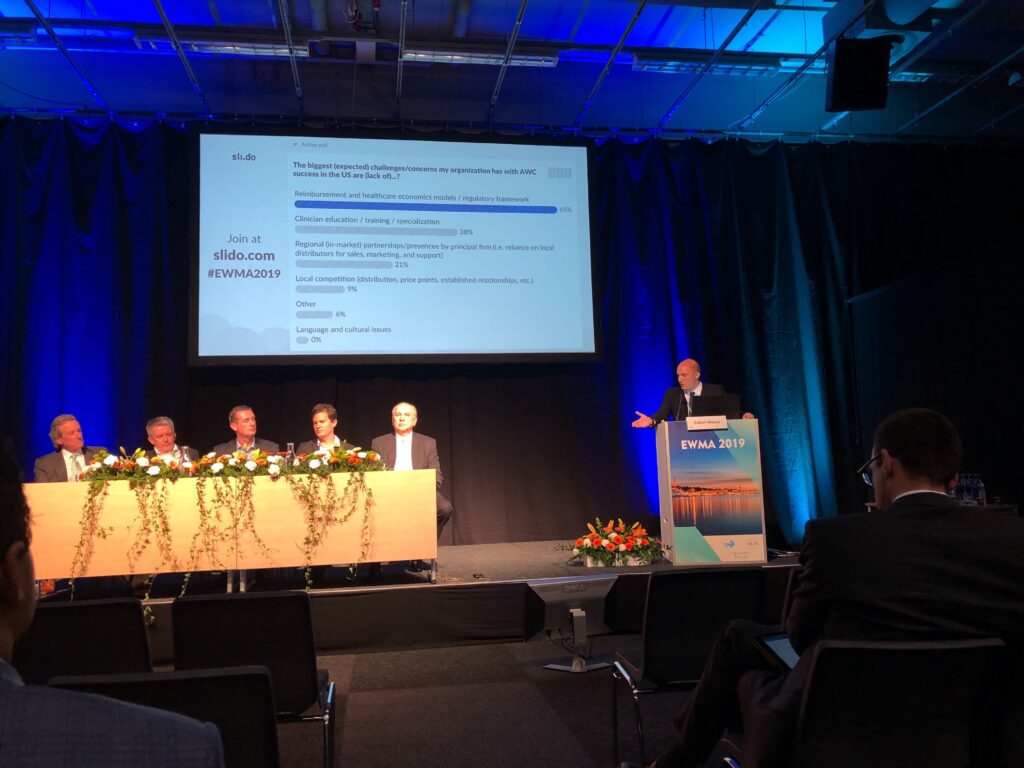
- Poll participants were most concerned with the reimbursement, healthcare economics, and regulatory frameworks.
- This was followed by a perceived lack of clinician education / training / specialization.
- Challenges related to language, culture, and local competition were of least concern.
- Some of our panelists articulated the unsustainable nature of the US fee-for-service model, and how that must change.
- Others expressed less concern regarding the sustainability of the system as a whole, but acknowledged the reality of new dynamics. In the words of one executive on our panel, “It used to be that in the US, you could have a better product, and charge a premium price, or you could have a slightly inferior product, but at a slightly lower price. Now, the expectation is that your product will be both better and less expensive.”
- There was some optimism from the panel around the HEOR (healthcare economics and outcomes research) models which have been built out in Europe and other markets, which may get some mileage in the US given the recent market forces trends; However, overall there also seemed to be quite a bit of hesitation as to whether the AWC industry as a whole has figured out / made enough progress in this area to “put their money where their mouths are” and actually take their products and protocols to the payers with a guaranteed outcome.
- One area where most of the panel agreed (at least those who spoke to this topic) is on the need for some better standards in the industry–whether for product claims, clinical trial design, or others.
- On the topic of recent high levels of M&A and digital health activity/investment, the consensus from the panel is that it is not just a fluke, and will absolutely continue into the foreseeable future.
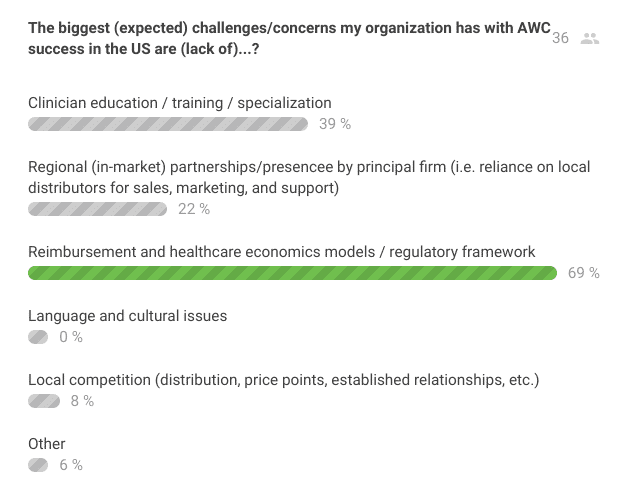
Asia Pacific Advanced Wound Care Trends, Challenges, and Opportunities:
- Poll participants were most concerned with local competition (distribution, price points, established relationships, etc.) and the lack of / difficulty in establishing a regional presence by the principal firm (i.e. needing to rely on local distributors for sales, marketing, and support).
- Interestingly, intellectual property (IP) concerns were cited by a minority of survey participants. Yet our executive panel did seem to express significant concern about it, explaining how such risk impacts all decisions, from product design to partnership selection.
- Compared to the poll on the US a few minutes prior, the challenges concerning Asia were much more varied (no individual option reached a 50% majority), implying that participants view AWC challenges in Asia as more diverse and dynamic.
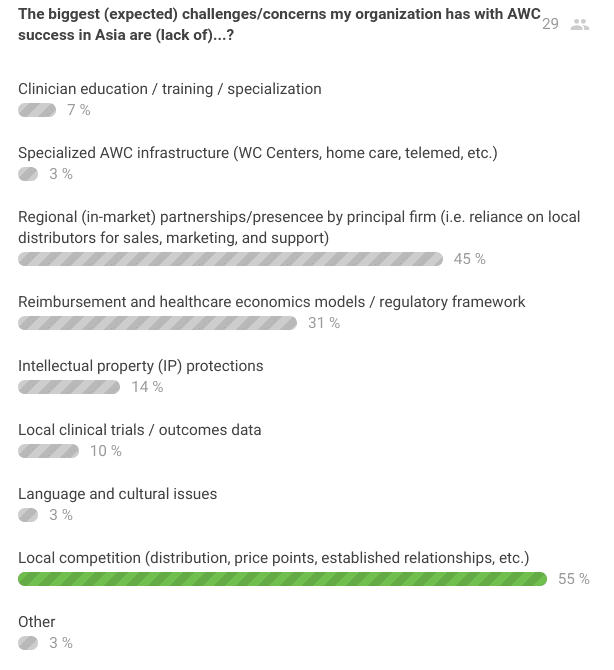
- A majority (52%) of poll participants considered China (followed by Japan) to be the greatest mid to long term AWC opportunity in Asia–a perspective that the panelists seemed to echo–yet there was still enthusiasm around all of the Asian geographies given as options. We discussed the demographics of an aging population and the practical remnants of the “One Child Policy” on healthcare needs such as advanced wound care: A couple (two people) caring for four parents plus their own children, and how that impacts the time and financial resources to deal with conditions such as chronic wounds. In addition to aging, the sheer size of the population (China and India alike), the socioeconomic trends, and the potential for local partnerships were all highlighted by the panel as drivers they consider when evaluating the commercial potential of specific Asian markets.
- The concept around what is allowed in Asia from a legal and regulatory perspective was discussed: For example, it is not uncommon in many Asian markets for healthcare providers to be proprietors of product distributorships, or for product manufacturers to openly own and operate their own healthcare / wound care service lines.
- Still, even our executive panel admitted to fundamentally struggling with wound care in Asia. They all appreciated the opportunity, and some offered up some victories in terms of establishing local partnerships and driving educational efforts. Yet admittedly, none have managed to “crack the nut.” One of the executives who came from a pharma background remarked how for most big pharma companies, China is their second or third largest market–with many times more sales and marketing reps there compared to countries in Western Europe. When it comes to advanced wound care, however, the relationship is totally flipped.
- We discussed some of the digital and educational initiatives each company has explored in recent years, and which components might be leveraged to drive AWC in Asia (and in other markets, too). Each of the participating firms have some form of digital strategy and presence, but they have begun to manifest themselves in different forms at each respective organization.
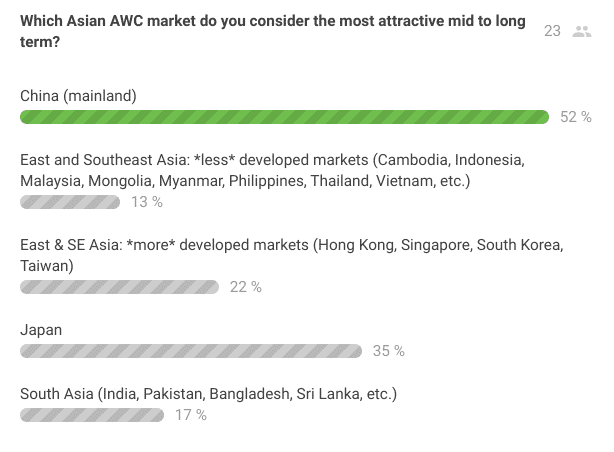
Final Thoughts
All in all, our Executive Industry Forum was extremely well received. Several companies hold global team meetings at EWMA, and as such, it was a chance to get some new, external perspectives to some of the realities that all of the major AWC players are facing. All of the executives in the panel articulated their respective companies’ visions and approaches in such a way that they came across as places where stakeholders would want to work and do business with.
Perhaps most importantly–and this is something I shared from the stage as well–even I was surprised to learn that most of our panel participants had never met each other prior to the forum. These are all industry veterans, who have all attended EWMA and the other key conferences, likely even brushing past each other on multiple occasions. The opportunity to openly discuss successes and struggles with one another resulted in some mutually agreed upon priorities. Some level of collaboration to address some of the common challenges consistently facing the top wound care players has the potential to elevate the industry as a whole, and it looks like that just may begin to happen. Without a doubt, that was the most important takeaway of them all.
Did any topics and insights in particular from the EWMA itself and/or the Executive Industry Forum catch your attention? Were specific opportunities left out? If you are in need of a trusted wound care business consultant, contact us to discuss your unique situation.
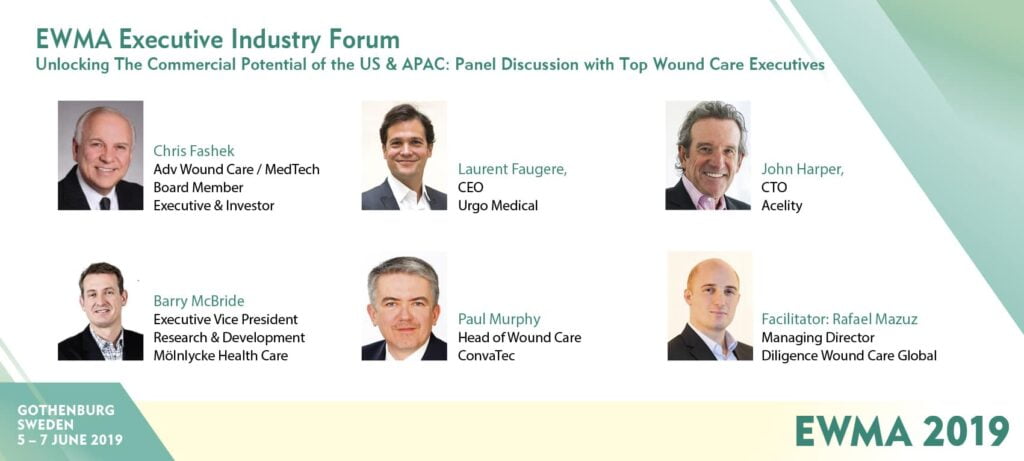




Great follow up Rafi. Really enjoyed the opportunity to participate.
Thanks, John! Your presence and contributions were priceless!